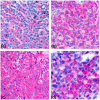Blastic Plasmacytoid Dendritic Cell Neoplasm: State of the Art and Prospects
- PMID: 31035408
- PMCID: PMC6562663
- DOI: 10.3390/cancers11050595
Blastic Plasmacytoid Dendritic Cell Neoplasm: State of the Art and Prospects
Abstract
Blastic plasmacytoid dendritic cell neoplasm (BPDCN) is an extremely rare tumour, which usually affects elderly males and presents in the skin with frequent involvement of the bone-marrow, peripheral blood and lymph nodes. It has a dismal prognosis, with most patients dying within one year when treated by conventional chemotherapies. The diagnosis is challenging, since neoplastic cells can resemble lymphoblasts or small immunoblasts, and require the use of a large panel of antibodies, including those against CD4, CD56, CD123, CD303, TCL1, and TCF4. The morphologic and in part phenotypic ambiguity explains the uncertainties as to the histogenesis of the neoplasm that led to the use of various denominations. Recently, a series of molecular studies based on karyotyping, gene expression profiling, and next generation sequencing, have largely unveiled the pathobiology of the tumour and proposed the potentially beneficial use of new drugs. The latter include SL-401, anti-CD123 immunotherapies, venetoclax, BET-inhibitors, and demethylating agents. The epidemiologic, clinical, diagnostic, molecular, and therapeutic features of BPDCN are thoroughly revised in order to contribute to an up-to-date approach to this tumour that has remained an orphan disease for too long.
Keywords: blastic plasmacytoid dendritic cell neoplasm; chemotherapy; clinics; gene expression profile; morphology; mutational landscape; phenotype; targeted therapy.
Conflict of interest statement
The authors declare no conflict of interest.
Figures



References
-
- Swerdlow S.H., Campo E., Harris N.L., Jaffe E.S., Pileri S.A., Stein H., Thiele J., editors. World Health Organization Classification of Tumours. 4th ed. International Agency for Research on Cancer; Lyon, France: 2017. WHO Classification of Tumours of Haematopoietic and Lymphoid Tissues.
-
- Sapienza M.R., Fuligni F., Agostinelli C., Tripodo C., Righi S., Laginestra M.A., Pileri A., Mancini M., Rossi M., Ricci F., et al. Molecular profiling of blastic plasmacytoid dendritic cell neoplasm reveals a unique pattern and suggests selective sensitivity to NF-kB pathway inhibition. Leukemia. 2014;28:1606–1616. doi: 10.1038/leu.2014.64. - DOI - PMC - PubMed
-
- Lennert K., Remmele W. Karyometric research on lymph node cells in man. I. Germinoblasts, lymphoblasts & lymphocytes. Acta Haematol. 1958;19:99–113. - PubMed
-
- Facchetti F., De Wolf-Peeters C., Kennes C., Rossi G., De Vos R., van den Oord J.J., Desmet V.J. Leukemia-associated lymph node infiltrates of plasmacytoid monocytes (so-called plasmacytoid T-cells). Evidence for two distinct histological and immunophenotypical patterns. Am. J. Surg. Pathol. 1990;14:101–112. doi: 10.1097/00000478-199002000-00001. - DOI - PubMed
Publication types
Grants and funding
LinkOut - more resources
Full Text Sources
Other Literature Sources
Research Materials

